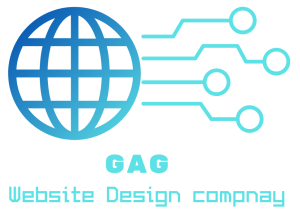In today’s digital age, “Website Design Mistakes ” a professional online presence is essential for businesses to thrive. Central to this presence is an effective website design. Your website serves as the virtual face of your brand, making it crucial to get it right. However, navigating the world of web design can be tricky, with numerous pitfalls that can hinder your online success. In this article, we’ll explore key website design mistakes to avoid, empowering you to create a compelling online presence that captivates your audience and drives business growth.
Introduction to Professional Online Presence

In the digital era, establishing a professional online presence is imperative for businesses of all sizes. Your online presence acts as the gateway through which potential customers interact with your brand, make purchasing decisions, and form perceptions about your products or services. A well-crafted online presence not only enhances brand credibility but also facilitates customer engagement and fosters trust.
- Significance of Online Presence: With the majority of consumers turning to the internet to research products and services, having a robust online presence is non-negotiable. It serves as a round-the-clock storefront, accessible to anyone with an internet connection. Whether you operate a small local business or a multinational corporation, a strong online presence allows you to reach a wider audience and compete effectively in today’s competitive marketplace.
- First Impressions Matter: Your website is often the first point of contact between your brand and potential customers. Just as a physical storefront should be inviting and well-maintained, your online presence should exude professionalism and credibility. A poorly designed website can deter visitors within seconds, resulting in lost opportunities and damaged brand reputation.
- Building Trust and Credibility: A professionally designed website instills confidence in your brand and conveys a sense of trustworthiness to visitors. Elements such as clean layout, intuitive navigation, and high-quality content contribute to a positive user experience, encouraging visitors to explore further and engage with your brand. Trust is a cornerstone of customer relationships, and a polished online presence helps to establish it from the outset.
- Competitive Advantage: In a crowded marketplace, differentiation is key to standing out from competitors. An effective online presence not only showcases your unique value proposition but also highlights what sets you apart from similar businesses. By aligning your website design with your brand identity and target audience preferences, you can carve out a distinct niche and attract loyal customers.
- Adaptability and Evolution: The digital landscape is constantly evolving, with new technologies and trends shaping consumer behavior and expectations. An effective online presence is not static but adaptive, capable of evolving with changing market dynamics and user preferences. Regular updates and enhancements to your website ensure that it remains relevant and competitive in an ever-changing environment.
Importance of Website Design Mistakes for Businesses
In the digital age, where consumers increasingly rely on the internet to discover and engage with brands, website design plays a pivotal role in shaping the success of businesses. Here’s a detailed exploration of why website design is crucial for establishing and maintaining a competitive edge in today’s marketplace:
- First Impressions and Brand Perception: Your website serves as the virtual storefront of your business. Just as a well-designed physical store can attract customers, a visually appealing and user-friendly website creates a positive first impression. A professionally designed website reflects the values and aesthetics of your brand, instilling trust and confidence in visitors from the moment they land on your site.
- User Experience (UX) and Conversion Rates: Website design significantly influences the user experience, which directly impacts conversion rates and overall business success. A seamless and intuitive navigation system, clear calls-to-action, and optimized page layouts enhance usability and guide visitors towards desired actions, such as making a purchase or submitting a contact form. Conversely, a cluttered or confusing website layout can frustrate users and drive them away, leading to lost opportunities for engagement and conversion.
- Mobile Responsiveness and Accessibility: With the proliferation of smartphones and tablets, mobile responsiveness has become a critical aspect of website design. A responsive website adapts seamlessly to various screen sizes and devices, ensuring a consistent and user-friendly experience across desktops, laptops, smartphones, and tablets. By prioritizing mobile responsiveness, businesses can reach a broader audience and cater to the growing segment of mobile users, thereby maximizing engagement and conversion opportunities.
- Search Engine Optimization (SEO) and Visibility: Effective website design goes hand in hand with search engine optimization (SEO), as it influences factors such as page load speed, site structure, and mobile-friendliness, all of which are crucial for search engine rankings. A well-optimized website not only attracts organic traffic from search engines but also enhances visibility and discoverability among potential customers. By incorporating SEO best practices into the design process, businesses can improve their online visibility and compete more effectively in search engine results pages (SERPs).
- Brand Consistency and Trustworthiness: Consistency is key to building a strong and memorable brand identity. A cohesive website design that aligns with your brand’s visual elements, messaging, and values reinforces brand consistency and fosters trust among visitors. When the look and feel of your website are consistent with other brand touchpoints, such as social media profiles and marketing materials, it reinforces credibility and professionalism, making visitors more likely to engage with your business.
- Competitive Advantage and Differentiation: In a crowded marketplace, a well-designed website can serve as a powerful differentiator, helping businesses stand out from competitors and attract the attention of potential customers. By investing in thoughtful design and user experience enhancements, businesses can create a unique and memorable online presence that sets them apart from the competition. Whether through innovative features, captivating visuals, or personalized interactions, website design can be a strategic tool for gaining a competitive edge and driving business growth.
Clarity and Consistency in Design Elements
Clarity and consistency in design elements are essential aspects of effective website design. These principles ensure that visitors can easily navigate and understand your website’s content, leading to a positive user experience and increased engagement. Let’s delve into the importance of clarity and consistency in various design elements:
- Clear Navigation Menus: Navigation menus serve as roadmaps for visitors, guiding them to different sections of your website. A clear and intuitive navigation structure makes it easy for users to find the information they’re looking for without getting lost or frustrated. Organize menu items logically, using descriptive labels that accurately represent the content within each section. Avoid cluttering the navigation bar with too many options, as this can overwhelm users and hinder their ability to navigate efficiently.
- Consistent Branding Elements: Consistency in branding elements, such as logos, colors, fonts, and imagery, reinforces brand identity and fosters recognition. Use your brand’s logo prominently across all pages of your website to establish brand familiarity and trust. Maintain consistency in color schemes and typography throughout your site to create a cohesive visual experience. Consistent branding elements help to create a unified and memorable impression, strengthening brand recall and reinforcing brand values.
- Clear Calls-to-Action (CTAs): Calls-to-action prompt users to take specific actions, such as signing up for a newsletter, making a purchase, or contacting your business. Design CTAs to stand out visually with contrasting colors, compelling copy, and prominent placement on the page. Ensure that CTAs are clear and concise, conveying the intended action to users without ambiguity. Consistent placement and styling of CTAs across different pages of your website help to guide users towards conversion goals and facilitate user engagement.
- Readable Typography: Typography plays a crucial role in the readability and accessibility of your website’s content. Choose legible fonts that are easy to read across various devices and screen sizes. Maintain a harmonious hierarchy of text sizes and styles to prioritize important information and guide users’ attention effectively. Consistency in typography enhances the visual coherence of your website and ensures a comfortable reading experience for visitors.
- Whitespace and Visual Balance: Whitespace, also known as negative space, refers to the empty space between design elements on a webpage. Proper use of whitespace enhances visual clarity and improves the overall readability of your content. Ensure adequate spacing between text, images, and other elements to prevent overcrowding and maintain visual balance. Consistent use of whitespace throughout your website creates a sense of elegance and sophistication, elevating the overall design aesthetic.
- Accessibility Considerations: Accessibility is an essential aspect of inclusive design, ensuring that all users, including those with disabilities, can access and interact with your website effectively. Design with accessibility in mind by providing alternative text for images, using descriptive link text, and ensuring keyboard navigability. Consistent adherence to accessibility guidelines improves usability for all users and demonstrates a commitment to inclusivity and diversity.
Responsive Design for Multi-Device Accessibility

In the modern era where users access websites through a variety of devices, responsive design has become imperative for ensuring optimal user experience across different screen sizes and resolutions. Let’s explore the significance of responsive design and its impact on multi-device accessibility:
- Adaptability to Various Devices: Responsive design enables websites to adapt fluidly to different devices, including desktops, laptops, smartphones, and tablets. Instead of creating separate versions of a website for each device, responsive design utilizes flexible layouts, fluid grids, and media queries to dynamically adjust the presentation of content based on the user’s screen size and orientation. This adaptability ensures that users receive an optimized experience regardless of the device they’re using, eliminating the need for pinching, zooming, or scrolling horizontally.
- Improved User Experience: A responsive website provides a seamless and consistent user experience across all devices, enhancing usability and accessibility. By prioritizing elements such as legible text, touch-friendly navigation, and appropriately sized tap targets, responsive design ensures that users can interact with the site comfortably and intuitively on any device. A positive user experience contributes to higher engagement, increased time on site, and lower bounce rates, ultimately driving conversions and fostering customer satisfaction.
- Enhanced SEO Performance: Responsive design is favored by search engines like Google, as it consolidates website content into a single URL, making it easier for search engine bots to crawl and index. With a single, unified website structure, responsive design eliminates the risk of duplicate content and ensures consistent ranking signals across different devices. Google also prioritizes mobile-friendly websites in its search results, meaning that responsive design can have a positive impact on search engine visibility and organic traffic.
- Cost-Effectiveness and Maintenance Efficiency: Maintaining separate desktop and mobile versions of a website can be resource-intensive and time-consuming. Responsive design streamlines the development process by creating a single, adaptable website that works seamlessly across all devices. This approach reduces development costs and simplifies ongoing maintenance, as updates and content changes only need to be implemented once, rather than across multiple versions of the site. By maximizing efficiency and scalability, responsive design offers long-term cost savings for businesses.
- Future-Proofing Against New Devices: The landscape of digital devices is constantly evolving, with new smartphones, tablets, and other gadgets being introduced regularly. Responsive design future-proofs your website by ensuring compatibility with emerging devices and screen sizes. Instead of redesigning your website from scratch each time a new device enters the market, responsive design enables your site to adapt effortlessly to changing technological landscapes, preserving usability and accessibility for users across all devices.
- Global Reach and Accessibility: In an increasingly interconnected world, responsive design facilitates global reach and accessibility by accommodating users from diverse geographical locations and demographic backgrounds. Whether users access your website from urban centers with high-speed internet connections or rural areas with limited bandwidth, responsive design ensures a consistent and accessible experience for all. This inclusivity aligns with principles of diversity and equity, allowing businesses to connect with audiences around the world regardless of their device preferences or capabilities.
Navigation and User Experience Optimization Website Design Mistakes
Navigation and user experience (UX) optimization are critical aspects of website design that directly impact how users interact with your site. A well-designed navigation system and intuitive user experience ensure that visitors can easily find the information they need and navigate through your website seamlessly. Let’s delve into the key components of navigation and UX optimization:
- Intuitive Navigation Structure: A clear and intuitive navigation structure is the backbone of a user-friendly website. Organize your website’s content hierarchically, grouping related pages under logical categories. Use descriptive labels for navigation menu items that accurately represent the content they link to. Consider implementing dropdown menus or mega menus for sites with extensive content to streamline navigation and make it easier for users to find what they’re looking for.
- Consistent Navigation Elements: Consistency is key when it comes to navigation elements across your website. Maintain consistent placement, styling, and behavior of navigation menus and links to avoid confusion and enhance usability. Users should be able to predict where to find navigation elements on different pages of your site, fostering a sense of familiarity and reducing cognitive load.
- Mobile-Friendly Navigation: With the increasing prevalence of mobile browsing, it’s essential to prioritize mobile-friendly navigation. Design navigation menus and buttons with touchscreen interactions in mind, ensuring they are large enough to tap easily and spaced apart to prevent accidental clicks. Consider implementing mobile-specific navigation patterns, such as hamburger menus, to optimize screen space and provide a seamless experience for mobile users.
- Search Functionality: In addition to traditional navigation menus, include a search functionality on your website to empower users to find specific content quickly. Implement autocomplete suggestions and filters to assist users in refining their search queries and locating relevant information efficiently. Ensure that search results are displayed clearly and include relevant metadata, such as page titles and descriptions, to help users assess the relevance of each result.
- Breadcrumb Navigation: Breadcrumb navigation provides users with a secondary navigation aid, indicating their current location within the website’s hierarchy and allowing them to navigate back to higher-level pages easily. Implement breadcrumb trails near the top of each page to provide context and help users understand their navigation path within your site. Breadcrumbs enhance usability, especially for sites with deep content hierarchies or complex navigation structures.
- User Feedback and Testing: Solicit feedback from users and conduct usability testing to identify any pain points or areas for improvement in your website’s navigation and user experience. Analyze user behavior through heatmaps, click tracking, and session recordings to gain insights into how users interact with your site and identify common navigation patterns or bottlenecks. Use this data to iteratively refine and optimize your website’s navigation for better usability and user satisfaction.
Website Design Mistakes Content Organization and Readability

Effective content organization and readability are essential elements of website design that directly influence user engagement and satisfaction. By organizing your content in a clear and structured manner and ensuring readability across devices, you can enhance the user experience and keep visitors engaged. Here’s a detailed look at strategies for optimizing content organization and readability:
- Hierarchy and Structure: Establish a clear hierarchy for your content to guide users through the information on your website. Use headings, subheadings, and bullet points to break up text and organize content into digestible chunks. This hierarchical structure not only improves readability but also helps users navigate your website more efficiently, allowing them to find relevant information quickly.
- Visual Hierarchy: In addition to text-based hierarchy, utilize visual cues to emphasize important content and guide users’ attention. Use contrasting colors, larger fonts, bold text, or imagery to highlight key messages, calls-to-action, or sections of interest. Visual hierarchy aids in scanning and skimming, enabling users to identify the most relevant content at a glance.
- Consistent Formatting: Maintain consistency in formatting throughout your website to create a cohesive and polished look. Use consistent font styles, sizes, and colors for body text, headings, and other elements to establish a unified visual identity. Consistent formatting enhances readability and reinforces brand consistency, fostering a sense of professionalism and trustworthiness.
- Whitespace and Margins: Proper use of whitespace and margins improves readability by providing breathing room around text and other elements. Adequate spacing between paragraphs, images, and navigation elements prevents visual clutter and enhances legibility. Incorporate generous margins and padding to ensure content is not cramped or crowded, creating a more comfortable reading experience for users.
- Accessible Typography: Choose typography that is legible and easy to read across different devices and screen sizes. Opt for web-safe fonts with sufficient contrast against the background to ensure readability for all users, including those with visual impairments. Consider factors such as line spacing, line length, and letter spacing to enhance readability and reduce eye strain.
- Responsive Design: Ensure that your website’s layout and typography adapt gracefully to various screen sizes and resolutions through responsive design techniques. Text should remain legible and maintain optimal line lengths regardless of the device used to access the website. Responsive typography adjusts font sizes, line heights, and spacing dynamically to provide a consistent reading experience across desktops, tablets, and smartphones.
- Scannable Content: Break up lengthy blocks of text into shorter paragraphs and use headings, bulleted lists, and bold text to make content more scannable. Users often scan web pages rather than reading every word, so it’s essential to structure content in a way that allows them to quickly find the information they’re looking for. Scannable content improves usability and encourages users to engage with your content more effectively.
- Content Accessibility: Ensure that your website’s content is accessible to all users, including those with disabilities. Use semantic HTML markup, descriptive alt text for images, and proper heading structures to improve accessibility for screen readers and assistive technologies. Provide alternative formats for content, such as transcripts for videos and downloadable documents, to accommodate users with diverse needs.
Website Design Mistakes Conclusion
In conclusion, effective website design is paramount for businesses striving to establish a professional online presence and engage with their target audience effectively.
By avoiding common design mistakes and prioritizing clarity, consistency, navigation optimization, content organization, and readability, businesses can create compelling digital experiences that resonate with users and drive success.
A well-designed website not only enhances brand credibility and trustworthiness but also fosters user engagement, conversion rates, and long-term customer relationships.
As the digital landscape continues to evolve, businesses must remain vigilant in maintaining a user-centric approach to website design, adapting to emerging trends and technologies to stay ahead of the curve.
By embracing best practices in website design and continuously optimizing the user experience, businesses can cultivate a strong online presence that sets them apart from the competition and propels them towards sustainable growth and success in the digital age.
Frequently Asked Questions (FAQs) about Website Design
- Why is website design important for businesses? Website design is crucial for businesses because it serves as the virtual storefront of your brand, influencing how users perceive your business and interact with your products or services. A well-designed website enhances brand credibility, fosters user trust, and drives engagement and conversions.
- What are some common website design mistakes to avoid? Common website design mistakes include cluttered layouts, confusing navigation, inconsistent branding, slow loading times, inaccessible content, and poor mobile responsiveness. Avoiding these pitfalls ensures a seamless user experience and maximizes the effectiveness of your online presence.
- How can I optimize navigation and user experience on my website? To optimize navigation and user experience, focus on creating a clear and intuitive navigation structure, maintaining consistency in navigation elements, implementing mobile-friendly design, incorporating search functionality, utilizing breadcrumb navigation, and soliciting user feedback for continuous improvement.
- Why is content organization important in website design? Content organization is essential in website design because it enhances readability, facilitates information retrieval, and improves user engagement. Clear hierarchy, visual cues, consistent formatting, whitespace management, and scannable content make it easier for users to find and consume relevant information on your website.
- What role does readability play in website design? Readability is critical in website design as it directly impacts how users interact with your content. By ensuring accessible typography, responsive design, and scannable content, you can enhance readability and provide a more comfortable reading experience for visitors across all devices and platforms.
- How can I make my website accessible to all users? To make your website accessible to all users, utilize semantic HTML markup, provide descriptive alt text for images, use proper heading structures, and offer alternative formats for content, such as transcripts for videos and downloadable documents. Prioritizing accessibility ensures that all users, including those with disabilities, can access and interact with your website effectively.
- What are the benefits of investing in professional website design? Investing in professional website design yields numerous benefits, including improved brand credibility, enhanced user experience, increased engagement and conversions, better search engine visibility, and a competitive edge in the marketplace. A well-designed website is a strategic asset that drives business growth and success in the digital age.



